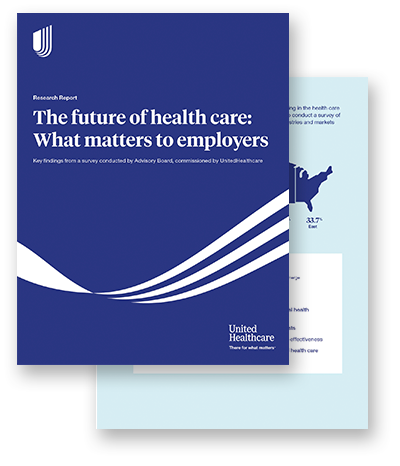What do employers want? Better chronic condition management.
Survey findings reveal that employers are looking to the health care industry for additional support in managing chronic conditions.
A survey conducted by Advisory Board and commissioned by UnitedHealthcare found that the majority of surveyed employers ranked the high costs of chronic disease management as the pain point they felt could benefit most from innovation.1
Asked to choose the top 3 areas for which they’re seeking more support from the health care industry in the next 5 years, 60% of respondents selected improving care management for costly conditions, while 55% selected advancing early identification and treatment.1
It’s no wonder because 6 in 10 adults in the U.S. have a chronic disease and 4 in 10 adults have 2 or more, according to the Centers for Disease Control and Prevention (CDC).2 Since treatment for chronic conditions may entail hospitalizations, pricey specialty medications and a higher utilization of medical services, the cost to employers can often be significant.
Facing a rising prevalence of chronic disease and its associated cost of care, employers are looking to the health care industry for additional support in managing these chronic conditions.
Strategies that are helping manage the cost of chronic conditions
Digital health solutions built to help manage chronic conditions, such as musculoskeletal (MSK) conditions and cancer, are of particular interest among employers given their ability to help lower expenses, encourage healthier lifestyles and improve connectivity of care for employees.
For instance, virtual offerings may also help move the needle on managing the cost of chronic conditions. In fact, the survey found that employers are currently investing in virtual care delivery innovations related to chronic care management, with:1
- 76% investing in digital communications with care providers
- 51% investing in remote patient monitoring
- 50% investing in virtual obesity and type 2 diabetes solutions
- 48% investing in technology-enabled at-home medication administration
- 43% investing in remote chronic pain management
Other strategies that may help include condition-specific health plans like Level2, which helps employees better manage their type 2 diabetes through a combination of self-care tools, coaching and clinical care. For example, one employer has experienced firsthand the impact this health plan can have on improving health outcomes, delivering a simpler health care experience and reducing their overall cost of care.
Specialized programs like the Cancer Guidance Program (CGP) — an evidence-based cancer treatment, utilization management and analytics service offered by UnitedHealthcare — can also help improve experiences and reduce health care costs.
Proactive prevention also matters
Prevention can be one of the best cost-saving strategies for chronic conditions. Offering wellness programs that provide rewards and incent employees and their family members for taking part in healthy behaviors may help. Programs like UnitedHealthcare Rewards, which offer rewards for activities like getting an annual appointment and walking a certain number of steps, is one example.
Employers should also work with their carrier to help encourage employees to complete their preventive care visits and regular screenings. This may catch diseases earlier, which could lead to more proactive intervention and potentially less costly treatment plans.
